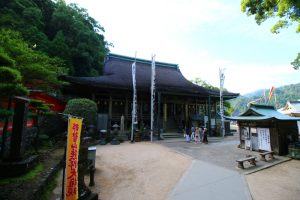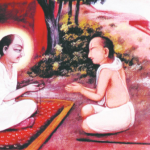Seiganto-ji Buddhism Temple, Japan
Buddhism ( Seiganto-ji ) is a major world religion and philosophy founded in northeastern India in the 5th century BC. It is based on the teachings of Siddhartha Gautama, commonly known as “The Buddha”, who was born in what is today Nepal. Buddhism takes as its goal the escape from suffering and from the cycle of rebirth: the attainment of nirvana. Buddhism in the present scenario is one of the most loved religions practised in the world. The religion is most popular among the youth because of its wonderful teachings which promote non-violence, truth and detachment from all the materialistic pleasures of the world. There are between 230 million and 500 million Buddhists worldwide.
Starting this week Religion World shall bring you the most spectacular Buddhist Temples across the globe. The architecture of Buddhist temples is influenced by the architecture of the country in which they are found and various traditions of Buddhist architecture. Japanese pagodas, for example, have unique Japanese features that are modelled after Chinese-style pagodas, which in turn were modelled after Indian stupas.

Because ancient wood temples were often destroyed by fire, temples today are usually made of brick and stone with brass and iron ornaments. Chinese pagodas were often built to commemorate important leaders or event or house important artefacts or documents. Many Buddhist temples are located in the forests and mountains. There is two reasons for their remote locations: first, mountains and forest have always been associated with spiritual purity, and second, Buddhist monks were often persecuted and remote location gave them some safety. In China, Japan and Thailand temples are often in the middle of town. Let us present you the most magnificent temples.
Seiganto-ji, Japan
Nachisan Seiganto-ji Temple is a Buddhist temple in Wakayama Prefecture. It is an old temple that was founded by an Indian monk who often trained in Nachi Falls behind the temple. It is designated as a UNESCO World Heritage site as part of the Sacred Sites and Pilgrimage Routes in the Kii Mountain Range. It is adjoined by the Kumano Nachi Taisha Shinto Shrine but what may surprise you is these two sites were actually originally dedicated to the same faith. (Up until around the 19th century, Shinto and Buddhism were combined and usually practised at the same time in Japan, and today there are numerous cultural relics of this belief.)
As for the shrine grounds, aside from the main shrine, there is a beautiful vermilion-coloured pagoda here. The sight of the pagoda in front of Nachi Falls is a picturesque sight. The principal object of worship at the shrine is a “hibutsu”, a Buddha image that is normally hidden from public view and only shown once every so often.
About Seiganto-ji
It is said (temple legend) that Seiganto-ji was founded by a monk from India with the name Ragyo-shonin during the 4th century. The original temple was the oldest in the Kumano area. The powerful samurai daimyo Oda Nobunaga (1534 – 1582) gave the order to burn the temple down. In 1587 the temple was rebuilt by shogun Toyotomi Hideyoshi. Nearly 300 years later the decision was made to reconstruct the famous three-story pagoda, which was destroyed by a huge fire at that time. This project was completed in 1972. In 2004 Seigantoji was designated as a UNESCO World Heritage Site.

History
During the reign of Emperor Nintoku (313 – 399), according to temple legend, Ragyō Shōnin, a monk from India, came here following the river in search of a suitable place in which to practice his austerities and found Nachi waterfall. After practising shugyō, Kannon appeared to him at the base of the waterfall and so he built a hermitage dedicated to Kannon in this place.
During the reign of Empress Suiko (592 – 628), Shōbutsu Shōnin came here from Yamato in order to undergo austerity practices. At that time he carved a 4-meter high image of Nyoirin Kannon from a single piece of camellia tree. The Hondō (main temple) was built to enshrine this image which became the focus of the Nachi Kannon cult and is the image that is enshrined in the present Nyorindō.
In 988 Emperor Kazan (968-1008) visited the Kumano area on his first pilgrimage and, being deeply moved by the image of Kannon, he declared this Temple One of the Saigoku Kannon pilgrimages. It is said that Emperor Kazan completed 1000 days of severe spiritual training under the waterfall, after which he had a vision of Kannon in the form of the kami Kumano Gongen. The kami instructed the emperor to find the priest Butsugan of Hasedera (Temple 8 of the pilgrimage), who helped the emperor to remap out the current pilgrimage route.

Emperor Kazan wrote all the goeika poems that are still used throughout the pilgrimage as sacred hymns. It became a custom in later years for other emperors who went on this pilgrimage to also compose poems of their own for each of the sacred sites.
Because Emperor Gotoba (1180-1239; r. 1183-1198) made the pilgrimage to Kumano 31 times and his successor Emperor Go-Shirakawa (1127 – 1192; reigned 1155 – 1158) made it 34 times, the pilgrimage became popular during this era. However, members of the court had been coming here for about 400 years prior to this, believing it was near to Kannon’s paradise island located to the south of Japan called Fudaraku (Potala in Sanskrit).
The temple buildings, like many of the temples on the pilgrimage route, were burned to the ground by Oda Nobunaga during the civil wars of the 16th century. The Nyorindō (Main Temple) was rebuilt in 1587 by Toyotomi Hideyoshi, the Imperial Regent who unified Japan after the wars. It is typical of Momoyama Era style of architecture with a shingled distinctive roof called irimoya. The Nyorindō is heritage listed as a nationally Important Cultural Property.

When the government reinstated the power of the Emperor during the Meiji era (1868 – 1912), an attempt was made to separate Buddhist temples and Shinto shrines that had for over a thousand years shared the same grounds. Because of this, Seigantoji was formally abolished, the priests stripped of their authority and no funding was given to the temple. At that time Seigantoji had three main temples as well as 37 residential and training building. But all that remained after the Meiji Restoration was the Nyorindō and the abbot’s quarters. However, gradually over the following century, it was slowly rebuilt due to its position as an important part of the Kumano-Nachi syncretic mountain veneration religion of Shugendō.
In 1918, a Sutra mound was excavated at the base of the waterfall and found to contain many important archaeological artefacts, including statues, mirrors, altar fittings and Sutra cylinders. These are now displayed in the Ryuhoden (“Treasure Hall”), located next to the Pagoda. These Sutra mounds were created by priests in times of war to hide their treasures but also many items were buried in this way as a result of the belief that the end of the world was coming at the start of the 10th century.

Building and Places of Interest within the temple grounds
Sanmon (Mountain Gate)
Kumano Nachi Taisha shrine (heiden)
Homotsuden Treasure Hall
Nyoirindō (The Temple of the Wish-fulfilling Kannon), the main temple (Hondō)
Sanjūdō pagoda (3-storey pagoda)
Nachi-no-Taki (Nachi Waterfall)
Nyohōdō (Hall of Lantern)
Sonsho-in Abbot’s Quarters
Waniguchi “Crocodile Mouth” Gong
Fudarakusan-ji









